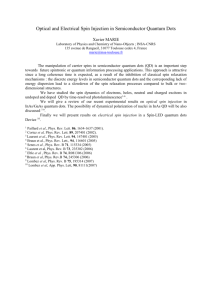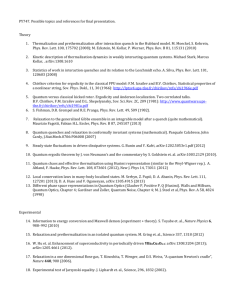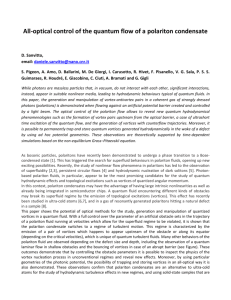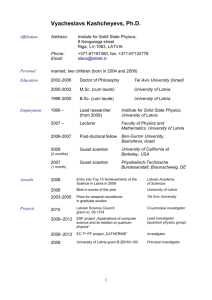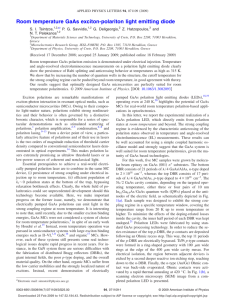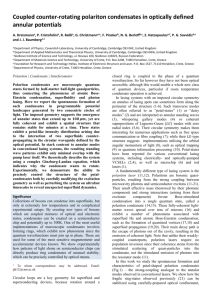Polariton Superfluids Reveal Quantum Hydrodynamic
advertisement
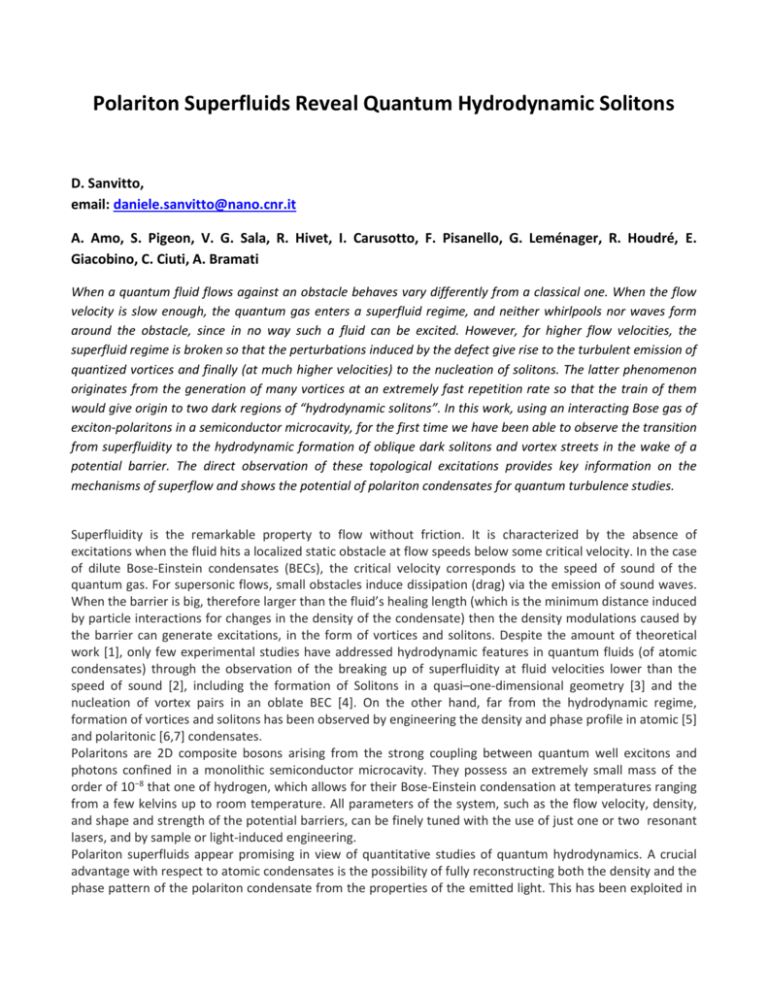
Polariton Superfluids Reveal Quantum Hydrodynamic Solitons D. Sanvitto, email: daniele.sanvitto@nano.cnr.it A. Amo, S. Pigeon, V. G. Sala, R. Hivet, I. Carusotto, F. Pisanello, G. Leménager, R. Houdré, E. Giacobino, C. Ciuti, A. Bramati When a quantum fluid flows against an obstacle behaves vary differently from a classical one. When the flow velocity is slow enough, the quantum gas enters a superfluid regime, and neither whirlpools nor waves form around the obstacle, since in no way such a fluid can be excited. However, for higher flow velocities, the superfluid regime is broken so that the perturbations induced by the defect give rise to the turbulent emission of quantized vortices and finally (at much higher velocities) to the nucleation of solitons. The latter phenomenon originates from the generation of many vortices at an extremely fast repetition rate so that the train of them would give origin to two dark regions of “hydrodynamic solitons”. In this work, using an interacting Bose gas of exciton-polaritons in a semiconductor microcavity, for the first time we have been able to observe the transition from superfluidity to the hydrodynamic formation of oblique dark solitons and vortex streets in the wake of a potential barrier. The direct observation of these topological excitations provides key information on the mechanisms of superflow and shows the potential of polariton condensates for quantum turbulence studies. Superfluidity is the remarkable property to flow without friction. It is characterized by the absence of excitations when the fluid hits a localized static obstacle at flow speeds below some critical velocity. In the case of dilute Bose-Einstein condensates (BECs), the critical velocity corresponds to the speed of sound of the quantum gas. For supersonic flows, small obstacles induce dissipation (drag) via the emission of sound waves. When the barrier is big, therefore larger than the fluid’s healing length (which is the minimum distance induced by particle interactions for changes in the density of the condensate) then the density modulations caused by the barrier can generate excitations, in the form of vortices and solitons. Despite the amount of theoretical work [1], only few experimental studies have addressed hydrodynamic features in quantum fluids (of atomic condensates) through the observation of the breaking up of superfluidity at fluid velocities lower than the speed of sound [2], including the formation of Solitons in a quasi–one-dimensional geometry [3] and the nucleation of vortex pairs in an oblate BEC [4]. On the other hand, far from the hydrodynamic regime, formation of vortices and solitons has been observed by engineering the density and phase profile in atomic [5] and polaritonic [6,7] condensates. Polaritons are 2D composite bosons arising from the strong coupling between quantum well excitons and photons confined in a monolithic semiconductor microcavity. They possess an extremely small mass of the order of 10−8 that one of hydrogen, which allows for their Bose-Einstein condensation at temperatures ranging from a few kelvins up to room temperature. All parameters of the system, such as the flow velocity, density, and shape and strength of the potential barriers, can be finely tuned with the use of just one or two resonant lasers, and by sample or light-induced engineering. Polariton superfluids appear promising in view of quantitative studies of quantum hydrodynamics. A crucial advantage with respect to atomic condensates is the possibility of fully reconstructing both the density and the phase pattern of the polariton condensate from the properties of the emitted light. This has been exploited in the recent observations of macroscopic coherence and long-range order [8], quantized vortices [6], superfluid flow past an obstacle [9,10], and persistent superfluid currents [7]. In this paper, a polariton condensate is used to reveal quantum hydrodynamic features, in particular the observation of dark solitons which are generated in the wake of a potential barrier. Following a recent theoretical proposal [11], different regimes are investigated at diverse flow speeds and densities, ranging from the superfluid regime to the turbulent emission of trains of vortices, which gives origin to the formation of pairs of oblique dark solitons of high stability as can be seen in the following figure. For spatially large enough barriers it is also possible to observe soliton quadruplets. This paper demonstrate the potential of polariton superfluids for the experimental studies of quantum hydrodynamics. Both the velocity and the density of the quantum fluid can be finely controlled by optical means, and simultaneous access to the condensate density, phase, and coherence is available from the emitted light from the condensate. These features have been essential in the reported observation and offer the opportunity to probe more complex phenomena like Andreev reflections, nucleation and trapping of vortex lattices, and quantum turbulence. Fig. 1 (a) Real-space emission showing a soliton doublet nucleated in the wake of a photonic defect located at the origin. The arrow indicates the direction of the polariton flow. (b) Interference between the emitted intensity and a constantphase reference beam, showing phase jumps along the solitons (dashed lines). (c) Horizontal cross section profile at a distances of 11 µm from the defect. The black arrows indicate the soliton position. (d) Soliton depth (black circles) and phase jump obtained from (b) (red triangles). References [1] T. Frisch, Y. Pomeau, S. Rica, Phys. Rev. Lett. 69, 1644 (1992); T. Winiecki, B. Jackson, J. F. McCann, C. S. Adams, J. Phys. At. Mol. Opt. Phys. 33, 4069 (2000); G. A. El, A. Gammal, A. M. Kamchatnov, Phys. Rev. Lett. 97, 180405 (2006). [2] C. Raman et al., Phys. Rev. Lett. 83, 2502 (1999); R. Onofrio et al., Phys. Rev. Lett. 85, 2228 (2000). [3] P. Engels, C. Atherton, Phys. Rev. Lett. 99, 160405 (2007). [4] S. Inouye et al., Phys. Rev. Lett. 87, 080402 (2001); T. W. Neely, E. C. Samson, A. S. Bradley, M. J. Davis, B. P. Anderson, Phys. Rev. Lett. 104, 160401 (2010). [5] S. Burger, K. Bongs, S. Dettmer, W. Ertmer, K. Sengstock, Phys. Rev. Lett. 83, 5198 (1999); J. Denschlag et al., Science 287, 97 (2000); J. J. Chang, P. Engels, M. A. Hoefer, Phys. Rev. Lett. 101, 170404 (2008). [6] K. G. Lagoudakis et al., Nat. Phys. 4, 706 (2008). [7] D. Sanvitto et al., Nat. Phys. 6, 527 (2010). [8] C. W. Lai et al., Nature 450, 529 (2007) ; E. Wertz et al., Nat. Phys. 6, 860 (2010). [9] A. Amo et al., Nature 457, 291 (2009). [10] A. Amo et al., Nat. Phys. 5, 805 (2009). [11] S. Pigeon, I. Carusotto, C. Ciuti, Phys. Rev. B 83, 144513 (2011).
